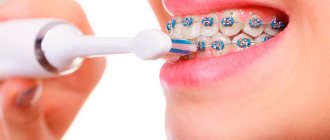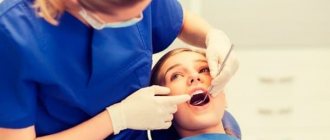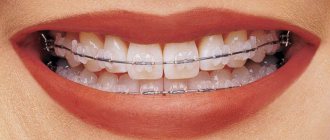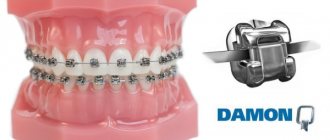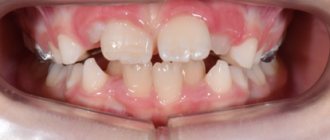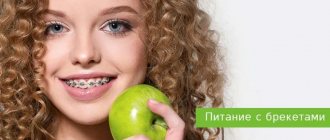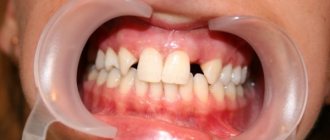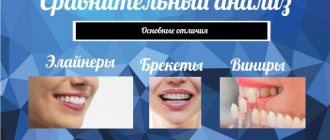The adaptation period after installing braces is associated with certain inconveniences for the patient. These include pain, discomfort, the appearance of diction defects, and damage to the oral mucosa.
Less often, patients turn to the dentist with a complaint about the loosening of one or more units with installed locks. This situation may indicate the beginning of the movement of teeth into the correct position or be a sign of a pathological process.
Distal bite: what is it and how does it happen?
This is an anomaly in which the lower jaw “retracts” to the rear position, and the upper jaw protrudes forward.
The defect may be mild and almost invisible. Or it turns out to be too obvious.
Braces correct distal occlusion, but you need to seek help from a professional who has many successfully treated clinical cases.
This violation is divided into types:
- Horizontal. The incisors of the upper jaw are inclined, raised towards the lip. The lower antagonists rest against the sky.
- Vertical. The upper incisors are inclined inward, often touching the gums near the lower ones.
The chin visually appears small. Doctors name several signs
, which indicate the severity of the pathology:
- There is a minor problem when the sixth upper and lower teeth are in contact.
- If closure is not observed, the unit ends up between the fifth and sixth antagonists, then urgent intervention is necessary and a long treatment process will be required.
The distal bite can be corrected and after wearing braces the profile becomes symmetrical and proportional.
Indications for installation
There are many indications for installing a brace system; these devices help to cope with both minor malocclusions and very serious pathologies. Common anomalies: open and deep bite. In the first case, the rows may not have points of contact in the frontal zone or on the sides, and in the second, the lower jaw strongly overlaps the upper jaw in front.
Braces can also help with facial asymmetry, crossbite (one of the jaws is underdeveloped), diastal (severe protrusion of the upper jaw) and medial bite (protrusion of the lower jaw). Other indications include severe crowding, rotation of units around their axis, as well as the presence of slots of different sizes, etc.
Only an experienced specialist can determine the need to install orthodontic structures and only on the basis of a preliminary examination of the patient’s oral cavity. The doctor will tell you which braces will be most effective and will solve existing problems as quickly as possible. The orthodontist will also tell you about all possible complications and symptoms that should alert you.
Signs of distal bite
Distal occlusion requires mandatory intervention from a specialist; treatment with braces is indicated; aligners can be used (especially when the diagnosis is made in childhood).
Signs of distal occlusion:
- The child spontaneously bites his lower lip
:
- The profile is slightly beveled. To define it, the term “avian” is used.
- The lips are thin and fall inside the oral cavity
. If you visually draw a line from the tip of the nose to the middle of the chin, then the lips will not appear on it:
- The lower third of the face is disproportionately small. A crease appears on the chin due to the jaw moving back.
It is possible to correct distal bite without braces when treatment is carried out in childhood. Aligners are approved for installation in children with baby teeth. They are installed in older preschool age, when the child can consciously follow the dentist’s recommendations.
In my practice, there are already more than 300 successful cases of bite correction using aligners. This is a promising method. Invisalign and FlexLiner aligners have proven themselves to be excellent in the treatment of distal occlusion. Star Smile aligners also correct this dental pathology quite well, although they require more careful attention from the attending physician. Whether correction of distal bite with aligners is right for you or your child can only be said with confidence during a consultation.
Treatment tactics
Initially, the dentist conducts a thorough examination of the patient’s oral cavity and determines the degree of mobility of the units. If necessary, additional diagnostics are prescribed.
If pathology is detected, the orthodontic system is removed and therapeutic measures are carried out. Depending on the type of disease, antibiotic therapy, filling, professional teeth cleaning, or splinting may be required.
Orthodontic treatment is continued after the disease that caused the loosening of the elements has been eliminated.
Structure mobility
Some patients are faced with the problem of loosening elements of the brace system: displacement or unsticking of clasps, deformation of the power arc, slipping of the ring. A similar phenomenon occurs due to neglect of the rules of operation of the orthodontic device.
If defects are detected in the structure of the device, the patient should make an appointment with the attending orthodontist. Before the visit, loose elements are secured with orthodontic wax.
The dentist will inspect and assess the condition of the system and offer a solution to the problem.
After removing the device
At the end of the orthodontic correction, the patient experiences discomfort and a feeling of unsteadiness of the elements for some time. Without the influence of the locks, the elements of the row tend to return to their usual position.
Ligaments and adjacent tissues are flexible and, if not fixed, teeth can shift again. Wearing retainers allows you to consolidate the correction effect. The duration of use of the devices depends on the patient’s age, the degree of pathology and the duration of orthodontic treatment. Removable or non-removable devices reliably hold elements and ligaments in the correct position, preventing their displacement and bite deformation. The minimum retention period is one year. Some patients have to use devices throughout their lives.
Tooth mobility during and after orthodontic treatment is a fairly common complaint. If this phenomenon is accompanied by pain, inflammation and swelling of the gums and other pathological symptoms, you should contact your dentist.
Reasons for the appearance of distal bite, why it is dangerous
The causes of the defect may be genetic disorders, especially in cases where relatives had a similar diagnosis.
Sometimes the occurrence of pathology is facilitated by a lack of nutrients, microelements, as well as bad habits.
– sucking toys, pacifiers.
Often, instead of a pacifier, the child uses a finger to suck
- which undoubtedly contributes to the development of distal occlusion:
The structure of the dental apparatus is disrupted in the presence of untreated diseases of the nasopharynx - breathing through the mouth provokes weakening of muscles, ligaments and jaws shift.
Correction of distal bite with braces is necessary. If you ignore pathology, you will have to overcome many problems.
Problems arising from distal occlusion:
- Diction is broken.
- There is no adequate chewing of food, not all foods are convenient to eat. Gastrointestinal ailments or somatic diseases develop.
- It is difficult to get dentures in the future.
- Uneven load often leads to loosening of units and destructive changes in tissues.
The dentist will make an initial conclusion during the first examination and order imaging to clarify the diagnosis.
Loosen to move
When installing a turnkey bracket system , the orthodontist first of all takes care of making the teeth mobile under the traction of the orthodontic arch, after which they can be forced to move along the calculated trajectory. And if they started to stagger, it means everything is going according to plan. How is it possible to first move them from their usual position, and finally re-fix them in the jaw bone?
Teeth with braces become loose due to the coordinated work of cells such as osteoblasts and osteoclasts. The dental crown and root are connected by a ligament, which, in turn, is supported by bone tissue. When the tooth begins to tilt under the influence of traction, the distance between the crown and the ligament increases on one side and decreases on the other. Osteoblasts begin to make up for the lack of bone tissue in order to support the tooth in a new place, and osteoclasts begin to remove the “excess” and dissolve it. In this case, the compressed connective ligament straightens out over time, and the tooth has the full right to take the new position planned by the orthodontist.
The cycles of resorption and growth during orthodontic treatment are repeated many times, causing a kind of “rejuvenation” and strengthening of bone tissue and, of course, correcting the dentition. But since it takes a lot of time to increase tissue density, and resorption occurs faster, the teeth remain mobile for a long time.
Treatment: distal bite before and after braces
From 11-13 years of age (early adolescence), distal bite is corrected with braces, treatment gives good results. Within a year and a half, the pathology disappears. Adults will need more time. The structure is a metal arc fixed on overlays glued to the enamel. The wire has a “memory effect” - gradually the lower jaw develops and takes on a physiologically justified position.
But a child with baby teeth is not given braces. How to correct a distal bite without braces? In this case, aligners come to the rescue - mouth guards made of transparent synthetic, absolutely harmless to the body. The child can easily take them off and put them on, they quickly get used to them. Visually, custom-made mouth guards are almost invisible. The growth of the lower jaw is stimulated. Intervention from 7-8 years is considered optimal. The tissues are flexible, and the child already understands the importance and necessity of treatment. Plates are also effective in childhood, but as aligners develop, they are placed a little less frequently.
To consolidate the effect, after removing braces, retainers are installed or mouth guards are used. After the braces are removed and the distal bite is corrected, you can forget about the imbalances that were observed before the intervention. And pay attention to what changes have occurred after treatment: the face becomes symmetrical, facial expressions become varied. The lips are already expressive and take on clear outlines. The person becomes uninhibited.
Don't ignore the problem. Come to me for an appointment, and we will choose the appropriate method for correcting your distal bite, taking into account your characteristics.
Contraindications
In addition to the indications for installing braces, there are also contraindications. They are usually divided into relative and absolute. The first ones are only a temporary obstacle; they can be dealt with by contacting a highly qualified specialist. This usually includes the presence of small neoplasms on the soft tissues of the oral cavity, as well as inflammatory processes.
Periodontal disease and periodontitis are not absolute contraindications; after a course of therapy, you can begin installing braces. Also, structures can be installed after treatment of bruxism, if the patient has crowns and artificial teeth. Having an allergy to metal will not be a contraindication, since today braces are made from a variety of materials.
Absolute contraindications are those that cannot be eliminated (HIV, oncology, diabetes and others). In this case, the patient may be offered alternative solutions to existing pathologies.
Which systems are better - with or without a ligature?
There is no clear answer to this question. From an aesthetic point of view, the best ones are those without ligature. For example, the H4 self-adjusting bracket system (OC Orthodontics) is considered one of the most aesthetic, and due to its variability and low profile, also the most effective.
It is important to understand that the main task of any brace system is to straighten the dentition and correct the bite, therefore, to correct uncomplicated anomalies, a system without a ligature is suitable, but to eliminate serious defects you will have to choose a traditional ligature design.
Only a competent orthodontist can choose the ideal braces for a patient, taking into account his individual dental characteristics, age and lifestyle.
At what age can you get braces?
Modern orthodontics allows you to solve the problem of crooked teeth and correct your bite at almost any age. It is most advisable to do this in young years, even before the final ossification of the jaws; the optimal time to begin bite correction in children is from 8 to 14 years. However, there are situations when correction is necessary for the patient in adulthood. Adults often seek correction of a bite that has been altered by the growth of wisdom teeth and subsequent displacement of adjacent teeth. Often the need for bite correction occurs after the removal of unhealthy teeth. The use of braces in such cases is the best way to eliminate defects.
How can I help the process?
While the tissues are weakened and the teeth are loose, it is necessary to prevent excessive stress on them.
- You should not chew whole hard carrots and hard apples, or bite caramels, nuts and seeds.
- Avoid viscous and sticky foods - dried fruits, toffees and chewing gum.
- Don't bite your nails, pens or pencils. In this way, you will not only protect weakened teeth, but also maintain the integrity of the braces system.
- Preference should be given to porridges, vegetable purees, and meat pates.
In order for bone regeneration to occur normally and the teeth to not become too loose by the time the orthodontic structure is removed, you need to include in your diet foods containing proteins, as well as all the necessary minerals and vitamins.
Cost of bite correction
In this case, the cost of the entire treatment (elimination of gum recession, orthodontic treatment with external braces and the Herbst apparatus, hygiene, treatment by an osteopath and consultation with a myofunctional therapist) amounted to 280,000 rubles. The cost of treatment is individual, as it depends on the complexity of the case and the equipment chosen. The approximate cost of treatment can be found out during a consultation with an orthodontist, and a more accurate one only after an in-depth diagnosis and approval of equipment for treatment.
Mouthguards
Mouthguards or aligners are also used to correct malocclusion in adults. They are made from plastic or silicone. This device is placed on the teeth and the teeth are gradually straightened. The mouth guard is removable, making it easier to care for your teeth.
It is used if braces cannot be installed. Also, a mouthguard is always used after correcting the bite in adult patients with braces. This is a must, otherwise the teeth may return to their original position.
Mouthguards for teeth straightening are standard, thermoplastic, and individual. They are expensive and ineffective in complex cases.
They say wearing braces is painful...
Indeed, braces therapy very often causes discomfort, and reviews from patients who have gone through this procedure indicate that there is little pleasant about it. This occurs due to the pressure of braces on the teeth. If the patient has a low pain threshold, the orthodontist will not tighten the system too tightly and will prescribe painkillers for the first time. If, a week after installing braces, the pain intensifies and the temperature rises, you should immediately consult a doctor to find out the reasons.
In the first weeks after braces are installed, the patient may experience significant discomfort and pain throughout the jaw. This reaction is due to the gradual movement of the teeth into the desired position and is considered normal - you will have to be patient.
Immediately after installing braces, parts of the system itself can injure the mucous membrane and tongue; this problem can be solved by using special wax as prescribed by a doctor. Gradually you will get used to it and stop feeling discomfort, and after a while you will get beautiful, straight teeth and the much-desired snow-white smile!



